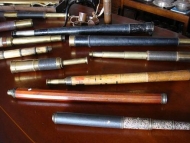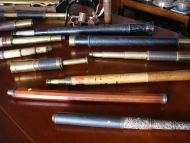In our warehouses, our customers will find a wide range of telescopes representing the history of this instrument. From 1700, when telescopes where still built in pressed cardboard, we move to 1800 with wood telescopes and to 1900 with much more compact brass telescopes. The Corsaro collection is continually updated and our items are always on display and available for purchase or rental.
|

The Telescope
It is commonly believed that it was Galileo to invent the telescope. He was certainly one of its first users, but the real inventor of the refracting telescope was Zacharias Jansenn, a spectacle-maker from Middleburg, Nederlands, in the first decade of the 17th century.
At that time the images sighted through optical instruments appeared fabulous, or perhaps the glass was of a very poor quality and spherical and chromatic aberrations blurred the image of microscopes.
The chromatic aberration is caused by an uneven refraction of light rays of different colours caused by a coloured margin around the image. Through a spherical lens, the focus of light rays crossing near the margin falls on that hit by central rays. |

The refracting telescope in which all optical parts are made of lenses, derives its name from the fact that light rays crossing the glass are refracted. It is the oldest type of telescope and was developed in three different shapes.
First, the astronomical telescope, with two “positive” lenses, which make light rays converge, and provide an upside down image. This type of refractor still exists today.
The second, is the one conceived for terrestrial use: it is provided with a 3-lens eyepiece system, besides the objective lens system. All such lenses are positive and the image is upright.
Only few of these types of telescopes of the 18th and early 19th century still exist. They are built in glued cardboard, covered in coloured parchment or fish skin. Around the 18th century, this type of telescope was built by wood tubes with brass lens slots.
From 1800, the improvement of brass tubes craftsmanship allowed for much more compact telescopes, with shorter tube sections, sliding one on top of the other. The brass tube was often painted and covered in wood, leather or, like in nautical telescopes, in rope braids.
The third type of refractor consists of an objective, which has a positive convergent lens with a divergent negative lens eyepiece. It’s called “Galilean”, because after 1610, this solution was made popular by Galileo. Such a solution was economical, as it only had two lenses, and the image was upright.
Naval telescope. |